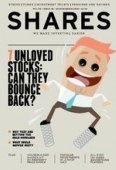Archived article
Please note that tax, investment, pension and ISA rules can change and the information and any views contained in this article may now be inaccurate.
Should you worry about ETFs that only track a handful of stocks?

One of the major attractions of exchange-traded funds (ETFs) is that they offer investors the opportunity to track virtually any market, asset or industry they choose. But investors should be aware that the more far-flung or niche the index they choose to track, the fewer stocks it is likely to contain.
ETFs following unusual fields can often invest in just a handful of names and that can seriously ramp up the risk for investors.
An ETF which follows the S&P 500 index, for example, is tracking the fortunes of 500 different companies. That means if the share price of one of the companies in this index plunges, the effect on the index as a whole is limited. The largest stock in the S&P 500 is Apple, which accounts for 4.4% of the index.
But less developed stock markets or indices have far fewer constituents. Expat Bulgaria Sofix ETF (BGX), for example, has just 15 shares in its portfolio. The three largest companies in the index by weighting account for more than 37% of assets.
Even where an ETF portfolio contains a decent number of names, there may still be concentration risk. iShares MSCI South Korea ETF (0JEW), for example, has 115 stocks in its portfolio, but some 22.4% of its assets are in Samsung Electronics. That means if Samsung’s shares have a bad day, it will have a significant impact on the performance of the ETF.
Examples such as these highlight the importance of checking under the bonnet of any investment before committing your money to it. ETFs by their very nature suggest diversification, but that may be difficult to achieve in particular assets or regions.
From a regional perspective, emerging markets are often more prone to this type of concentration risk. This is because there are often fewer companies listed on their stock markets and a handful of market leaders may account for a disproportionate amount of
the index.
While an emerging market fund manager can make a decision to deviate from those weightings and spread his assets more widely, an ETF simply follows the index.
Caroline Baron, head of ETF sales at Franklin Templeton, says: ‘There are 24 countries in the MSCI Emerging Market index but the top three countries – China, South Korea and Taiwan – represent 56% of the portfolio and the top three underlying holdings represent 13% of the index, which might be an issue if one of those starts to not perform.
‘We tend to see a similar pattern in many indices and this is why it might be important for investors to understand those potential risks when constructing a diversified portfolio.’
NICHE INDUSTRY FOCUS
Thematic products or those which track specific industries or trends may be more concentrated too, because there may be fewer companies operating within the space in which they are focused.
Amundi MSCI Europe Telecom Services ETF (CT5) has just 18 companies in its portfolio – all involved in the European telecoms industry. The largest holding, Vodafone (VOD), accounts for 19.9% of the portfolio and the top three holdings account for more than 50% of assets. Tracking a specific sector such as this one comes with the risk that regulation affecting the entire industry could change, sending all the holdings plunging at the same time.
Another example is iShares Global Timber and Forestry ETF (WOOD), which tracks just 25 companies in the industry, albeit they are spread across 16 different countries.
Another reason that ETF concentration is an important consideration is because it should have a major bearing on why you choose an investment in the first place.
You might, for example, select a FTSE 100 or S&P 500 tracker because you feel confident about the overall prospects for those markets. But when a fund has a quarter of its assets in one single stock, you need to feel confident about the prospects for that specific company.
Baron suggests that so-called smart beta ETFs may be a way of alleviating some of this concentration for investors who do want to use a tracker fund to access these regions.
Smart beta ETFs inject a dose of active management into passive investing by putting certain rules or a particular focus in place, such as limiting weighting or targeting stocks which generate a certain yield.
Baron adds: ‘Investors do need to look under the bonnet to fully understand what they are getting into but the good thing about ETFs is that their risks can be assessed very easily because all of their holdings are publicly available on a daily basis.’ This is different to active funds, which typically only make their largest 10 holdings available.
Just because an index is particularly concentrated, it doesn’t automatically mean you should not invest – after all a gold ETF only tracks the price of one thing: gold.
But it does mean you should have a very strong conviction in that index and be sure to do some research on the individual holdings first. (HB)
Important information:
These articles are provided by Shares magazine which is published by AJ Bell Media, a part of AJ Bell. Shares is not written by AJ Bell.
Shares is provided for your general information and use and is not a personal recommendation to invest. It is not intended to be relied upon by you in making or not making any investment decisions. The investments referred to in these articles will not be suitable for all investors. If in doubt please seek appropriate independent financial advice.
Investors acting on the information in these articles do so at their own risk and AJ Bell Media and its staff do not accept liability for losses suffered by investors as a result of their investment decisions.

 magazine
magazine








